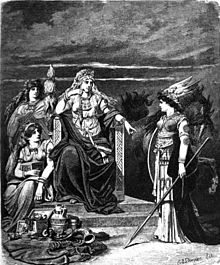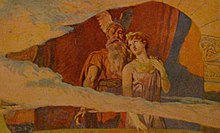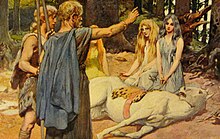Frigg
In Norse mythology, the source of most surviving information about her, she is associated with marriage, prophecy, clairvoyance and motherhood, and dwells in the wetland halls of Fensalir.
During modern times, Frigg has appeared in popular culture, has been the subject of art and receives veneration in Germanic Neopaganism.
The theonyms Frigg (Old Norse), Frīja (Old High German), Frīg (Old English), Frīa (Old Frisian), and Frī (Old Saxon) are cognates (linguistic siblings from the same origin).
[2][3][4] They stem from the Proto-Germanic feminine noun *Frijjō, which emerged as a substantivized form of the adjective *frijaz ('free') via Holtzmann's law.
Evidence is lacking for the existence of a common Germanic goddess from which Old Norse Freyja descends, but scholars have commented that this may simply be due to the scarcity of surviving sources.
[10] Regarding the Freyja–Frigg common origin hypothesis, scholar Stephan Grundy writes that "the problem of whether Frigg or Freyja may have been a single goddess originally is a difficult one, made more so by the scantiness of pre-Viking Age references to Germanic goddesses, and the diverse quality of the sources.
All of these terms derive from Late Proto-Germanic *Frijjōdag ('Day of Frijjō'), a calque of Latin Veneris dies ('Day of Venus'; cf.
The Old Norse weekday Freyjudagr, a rare synonym of Frjádagr, saw the replacement of the first element with the genitive of Freyja.
According to this legend, a "small people" known as the Winnili were ruled by a woman named Gambara who had two sons, Ybor and Agio.
The Vandals, ruled by Ambri and Assi, came to the Winnili with their army and demanded that they pay them tribute or prepare for war.
The incantation calls upon various continental Germanic gods, including Old High German Frija and a goddess associated with her—Volla, to assist in healing a horse: In the Poetic Edda, compiled during the 13th century from earlier traditional material, Frigg is mentioned in the poems Völuspá, Vafþrúðnismál, the prose of Grímnismál, Lokasenna, and Oddrúnargrátr.
In the first mention the poem recounts that Frigg wept for the death of her son Baldr in Fensalir.
Geirröðr, forward in the ship, jumped to shore and pushed the boat, containing his brother, out and said "go where an evil spirit may get thee.
"[21] Odin says: "'Seest thou Agnar, thy foster-son, where he is getting children a giantess [Old Norse gȳgi] in a cave?
A prose introduction to the poem describes that numerous gods and goddesses attended a banquet held by Ægir.
Frigg is first mentioned in the Prose Edda Prologue, wherein a euhemerized account of the Norse gods is provided.
"[25] In the next section of the Prose Edda, Gylfaginning, High tells Gangleri (the king Gylfi in disguise) that Frigg, daughter of Fjörgynn (Old Norse Fjörgynsdóttir) is married to Odin and that the Æsir are descended from the couple, and adds that "the earth [Jörðin] was [Odin's] daughter and his wife.
Frigg subsequently receives promises from the elements, the environment, diseases, animals, and stones, amongst other things.
Hermodr secures an agreement for the return of Baldr and with Hermóðr Nanna sends gifts to Frigg (a linen robe) and Fulla (a finger-ring).
However, the agreement fails due to the sabotage of a jötunn in a cave named Þökk (Old Norse 'thanks'), described as perhaps Loki in disguise.
The first mention occurs at the beginning of the section, where the Æsir and Ásynjur are said to have once held a banquet in a hall in a land of gods, Asgard.
"[35] A 12th century depiction of a cloaked but otherwise nude woman riding a large cat appears on a wall in the Schleswig Cathedral in Schleswig-Holstein, Northern Germany.
Due to iconographic similarities to the literary record, these figures have been theorized as depictions of Freyja and Frigg respectively.
[36] Due to numerous similarities, some scholars have proposed that the Old Norse goddesses Frigg and Freyja descend from a common entity from the Proto-Germanic period.
[10] Regarding a Freyja-Frigg common origin hypothesis, scholar Stephan Grundy comments that "the problem of whether Frigg or Freyja may have been a single goddess originally is a difficult one, made more so by the scantiness of pre-Viking Age references to Germanic goddesses, and the diverse quality of the sources.
Other examples include fine art works by K. Ehrenberg (Frigg, Freyja, drawing, 1883), John Charles Dollman (Frigga Spinning the Clouds, painting, c. 1900), Emil Doepler (Wodan und Frea am Himmelsfenster, painting, 1901), and H. Thoma (Fricka, drawing, date not provided).







